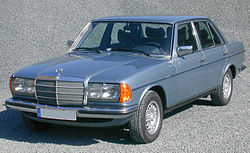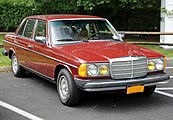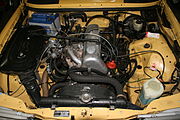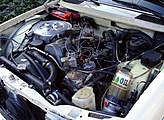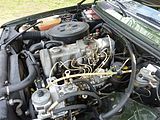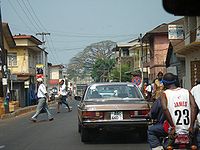Mercedes-Benz 123 series
| Mercedes Benz | |
|---|---|
|
Mercedes-Benz 280 E (1977)
|
|
| 123 series | |
| Sales designation: | 200-280 200 D-300 D 230 E / C / CE / TE, 240 TD, 250 T, 280 E / C / CE / TE, 300 TD turbodiesel |
| Production period: | 1975-1986 |
| Class : | upper middle class |
| Body versions : | Sedan , station wagon , coupé |
| Engines: |
Petrol engines : 2.0–2.8 liters (69–136 kW) Diesel engines : 2.0–3.0 liters (40–92 kW) |
| Length: | 4640-5355 mm |
| Width: | 1786 mm |
| Height: | 1395-1450 mm |
| Wheelbase : | 2795 mm |
| Empty weight : | 1340-1680 kg |
| Previous model | Mercedes-Benz W 114/115 |
| successor | Mercedes-Benz 124 series |
The 123 series is the most popular Mercedes-Benz model to date . It belongs to the upper middle class , now known as the E-Class at Mercedes-Benz . Predecessors are the W 114 (six-cylinder models) and the W 115 (four-cylinder and diesel models), also known as "Dash 8" (/ 8). Both the predecessor and the successor rolled off the assembly line for around a year in parallel with the W 123. The 123 series set standards in vehicle safety and was one of the first station wagons in this class as well as the first Mercedes-Benz passenger car with a turbodiesel engine .
From the start of series production in November 1975 to January 1986, a total of almost 2.7 million vehicles rolled off the assembly line. The series is the epitome of solidity.
Model history
General
The manufacturer's decision to leave Dash 8 in the range for around eleven months after the successor was introduced had several reasons. On the one hand, the tried and tested model was still very popular, especially in the taxi industry, and sold well. On the other hand, the newly presented W 123 was so well received by buyers that delivery times of more than a year already existed at the start of series production. During this time, the / 8 (W 114/115) was up to DM 2,400 cheaper than its successor, depending on the version. The purchase price of the W 123 when it was launched was between 18,870 DM (200) and 26,895 DM (280 E).
The delivery times for the new W 123 even increased to up to three years, which led to the fact that sales contracts for new cars were sometimes more than DM 5000 above the list price in order to get the coveted model faster. Year-old cars were also often resold at a premium. This has not been repeated for mass-produced vehicles in West German automotive history to this day.
The great success of the series is also reflected in the fact that the Mercedes 123 series - like its predecessor model, which ousted the VW Beetle from first place in the new registration statistics in 1974 - was the only vehicle to replace the VW Golf in first place in the registration statistics of the Federal Republic in one calendar year could: In 1980 the 123 series achieved a total of 202,252 registrations, while the Golf had 200,892 new registrations.
The 123 series was produced in four body variants : as a sedan with a notchback , as a long sedan with seven seats, as a coupé with a slightly shortened wheelbase and as a station wagon , which is called the Mercedes T-model . In addition, there were chassis with normal and extended wheelbases as the basis for special bodies such as ambulances or hearses .
At first, there were different headlights, depending on the engines used: Cars with the weaker engines were equipped with round headlights, also called disparagingly "ox eyes". Broadband halogen headlights featured the top models 300 TD Turbodiesel, the 280/280 E and the Coupés. Mercedes also upgraded these models with chrome-plated rubber lips under the rear lights and chrome-plated ventilation grilles in front of the windshield. As part of the facelift for the third series in September 1982, all models received the rectangular headlights, matt black ventilation grilles and a zebrano wood trim on the dashboard.
Models with petrol and diesel engines differ externally in the installation location of the Hirschmann radio antenna, if it was ordered from the factory (equipment code 53 / x). On the diesel models the antenna was mounted on the right front fender, on the models with petrol engines because of the electromagnetic field of the ignition system on the left rear. Fully automatic antennas were located on the rear left of all models for reasons of space.
The surcharge policy at Daimler-Benz in these years is worth mentioning: the price range ranged from around 18,000 DM in 1976 for the basic model to just under 80,000 DM in the last year of construction for a fully equipped 300 TD Turbo. With the optionally available Becker-TeKaDe car phone, the price increased by a further DM 20,000, making the T-model with these equipment features around three times as expensive as the basic S-class . The purchase price could easily double with just a few equipment features.
Facelift
The 123 series underwent many changes during its production time. The series can essentially be divided into the first series up to the facelift in August 1979, the second series until August 1982 and the third series . The first series is again subdivided into series 0.5 and first series :
- Series 0.5 : November 1975 to August 1976
- First series : August 1976 to July 1979
- Second series : August 1979 to August 1982
- Third series : September 1982 to January 1986
Examples of the so-called series 0.5 are very rare today, it differs from the first series only in details. Since stocks were sometimes still used up in production, there are so-called series twitter that have characteristics of different series.
essential features of the second series (from August 1979):
- smaller steering wheel (10 mm) in a more elegant design
- more modern toggle switches (hazard lights, window lifters, etc.)
- pneumatic headlight range control
- modified seat belt buckles and smaller headrests
- new fabric samples for the seats
significant changes of the third series (from September 1982):
- Rectangular headlights and power steering as standard
- Shaped front seat backrests for more knee room in the rear
- Fabric insert in the door panels
- Zebrano wood paneling in the dashboard
- new fabric samples and seats completely covered with fabric (no more artificial leather cheeks)
- less wind noise thanks to improved roof trims
- Ventilation grille no longer chrome-plated
Model variants
After the four-door sedan was introduced at the end of 1975, three more body variants were added from mid-1977: a coupé, a long-wheelbase sedan and, for the first time in the brand's history, a factory-built station wagon .
Saloon (W 123)
Mercedes-Benz presented the four-door versions of the W 123 on January 29, 1976 in southern France. Although there were some technical similarities to its predecessor, the wheelbase and external dimensions were larger. The exterior of the car has also been updated, although the stylistic similarity to the W114 / W115 has been retained. Initially, all models except the 280/280 E received round headlights, the broadband headlights were reserved for the six-cylinder models. All engines were carried over from the previous model, with the 3-liter 5-cylinder diesel being renamed from "240 D 3.0" to "300 D" (as was previously the case for the North American market).
Outwardly, the models 280 and 280 E differed from the simple four-cylinder models up to 1982 by chrome-plated bumpers and broadband halogen headlights drawn into the side panels. Light-alloy wheels were only available for the simple four-cylinder models from 1980. The sedan was manufactured in a total of around 2.4 million copies, almost 90 percent of all 123s were delivered this way. All engine types were available for this variant. Because of the fleet consumption regulations of the then US President Jimmy Carter , a 300 D Turbo was only offered in the USA.
Long version (V 123)
In August 1977 Mercedes-Benz presented the long version of the mid-size sedan: the V 123 had a wheelbase that was 630 millimeters longer (3425 mm) than the sedan (2795 mm). The middle door was welded together from the front part of a rear door and the rear part of a front door.
The length of the vehicle allowed enough space for a third bench seat and made it a comfortable taxi, company or hotel car for seven passengers. The 250, 240 D and 300 D models were offered as long versions. In the Middle East and Cyprus, these vehicles are still popular in taxi operations.
Coupé (C 123)
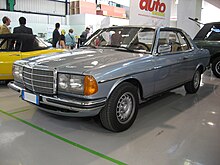
The presentation of the 123 coupes took place in June 1977. While the coupés of the / 8 series were stylistically closely based on the sedan, the new models 230 C, 230 CE, 280 C and 280 CE were significantly more independent. The wheelbase, which is 85 millimeters shorter than that of the sedan, combined with the lower roof and the steeply sloping front and rear windows, gave the car a squat appearance.
Vehicle safety has been improved compared to the coupés of the previous series: Together with the crumple zones inherited from the sedan , the stiffened roof frame structure with high-strength roof posts and reinforced doors resulted in an even more stable safety passenger cell. The engines, chassis and braking system were the same as those of the sedan.
In terms of equipment, the two-door versions were based on the upscale versions of the four-door top models 280 and 280 E. These included rectangular broadband halogen headlights, chrome-plated air inlet grilles in front of the windshield (until September 1982) and chrome-plated strips under the rear lights for all three coupés.
In the models of the first series, the dashboard and the center console were made of the “ burr walnut ” fine wood version , and from September 1979 the “Zebrano” fine wood version was used. The model upgrade in September 1982 had less of an impact on the coupés than on the sedans. After all, the broadband halogen headlights that have now been introduced for all models have always been part of the coupé's equipment. The younger coupés can best be recognized by the black ventilation grilles in front of the windshield that were not chromed from 1982 onwards. With the four-cylinder coupé 230 C (109 PS / 80 kW) and the two six-cylinder versions 280 C (156 PS / 115 kW) and 280 CE (185 PS / 136 kW), there were three coupé models with petrol engines at the start of production.
As early as autumn 1977, the 300 CD with 80 PS (59 kW) and thus a diesel coupé was added for the US market. Among other things, Mercedes wanted to reduce the average fuel consumption of Mercedes-Benz automobiles in the USA. After the limit values for the fleet consumption tightened further, the 300 CD was replaced by the 300 CD turbodiesel in 1981. This 92 kW Coupé was not offered for the European market either, but replaced the 280 CE model in the USA.
The 230 C was in 1980 replaced by 230 CE, the new M 102 engine with mechanical K-Jetronic - manifold injection made 100 kW.
Series production of the C 123 ended in the summer of 1985. A total of 99,884 vehicles of this type were built from June 1977 to August 1985, 15,509 of them with diesel engines.
T-model (S 123)
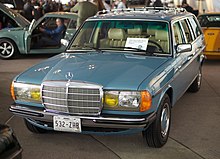
In 1966 and 1967 the fintail types of the 110 series were offered as "Universal" station wagons , the few (under 3000 pieces) station wagons manufactured in Belgium by IMA under a Daimler-Benz license remained exotic. Other Mercedes-Benz station wagons, undertaker vehicles and ambulances were all conversions by bodywork companies , as was the case with the W 114/115, of which there was no station wagon ex works. With the introduction of the T-model ten years later there were again Mercedes-Benz station wagons with the 123 series.
The results of the market research carried out during the conception of the 123 series showed that there was clear demand for a sporty, luxurious five-door model. The board of directors gave the green light for the project in 1975. The new Mercedes-Benz should not be called "station wagon"; The term "Universal", which was previously used for a short time, was not approved either. Initially, the designation "station wagon" was intended. Instead of “250 K” or “250 U”, the load compartment variant of the small six-cylinder would then have the abbreviation “250 St” on the tailgate. Finally the decision was made for the abbreviation “T”: the letter stands for tourism and transport. The station wagon models - known internally as the S 123 - were presented to the public at the International Motor Show in Frankfurt am Main in 1977.
In April 1978, series production of the T-Model (S 123) began at the Bremen plant . The vehicle is technically the same as the sedan: the drive, brakes and chassis are almost the same as the external dimensions (length, width and wheelbase). The station wagon has somewhat stronger brakes at the rear (42 mm instead of 38 mm brake pistons). The rear end with its high edge turned the new vehicle into a real space saver: even if the standard seats are occupied by the driver and passengers, the car still offers space for 523 liters of load up to the edge of the window. When the rear bench is folded down, the load space swallows up to the edge of the window 879 liters. The concept offered several possible variations in the design of the interior. The rear seat bench could be supplied as an optional extra with an asymmetrical division. Depending on requirements, one or two thirds of the backrest can then be folded down.
When it was launched, the T-Model was one of the first “lifestyle station wagons” whose manufacturers wanted to free the image of the “craftsman's car”: the interior was clad with high-quality materials, leather and velor upholstery were available from the start. There was no lacquered sheet metal in the interior that could have been reminiscent of a delivery van . A standard hydropneumatic level control on the rear axle ensures a high level of driving comfort regardless of the weight of the load, which is up to 45 percent of the unladen weight of the T-model, which weighs around 1500 kilograms. Upon request, it could be equipped with 15-inch wheels, other springs and shock absorbers and a stronger brake booster . This increased the T-model's payload from the standard 560 kilograms to 700 kilograms.
In addition, Mercedes offered a child bench in the cargo area and chrome roof rails. The railing became standard equipment in the summer of 1978. All T-models were fitted with carpeting throughout, including on the loading area. The new body variant was initially offered as 230 T, 250 T and 280 TE as well as 240 TD and 300 TD, in 1980 the 200 T, 230 TE and 300 TD turbodiesel were added. Light alloy wheels were available as special equipment for all models. The headlights of the 280 TE and 300 TD Turbodiesel were rectangular until 1982.
Special versions (F 123)
The 123 series often served as the basis for various bodies and conversions. For the police, fire brigade and rescue services, there were modified limousines and T-models as well as ambulances as superstructures from companies like Binz and Miesen . For taxi operations, Mercedes-Benz offered the sedan with a long wheelbase ex works. Superstructures as hearses and conversions as pick- ups or convertibles were ultimately created by external bodywork companies.
alternative drives
The 123 series also served as a test vehicle for alternative drive technology during its construction period . In 1983 Daimler-Benz presented a 280 TE with hydrogen drive as a test vehicle. There was also a test vehicle with an electric drive based on the T-model. A type 200 with a bivalent drive was available as a series model from 1982 onwards : The car was powered by liquefied petroleum gas or petrol, the driver selected the respective drive type via a switch. For the first time, these cars had a specially shaped, flat gas tank under the floor of the car, without the disadvantageous restriction of the trunk via the otherwise usual cylindrical tanks.
Conversions
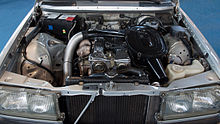
Various tuning versions of the series were offered by the companies AMG , Brabus and Lorinser during the construction period of the 123 series . The measures ranged from external changes to the body with the help of paintwork, the installation of spoilers, sills and various light alloy wheels to modifications of the chassis by lowering it, tighter damping and changing the camber on both axles. The performance of the series engines could be increased by appropriate measures, various companies also offered their own engines.
Motorsport
The long-distance rally London – Sydney was for Daimler-Benz 1977 after a long break with first place with a 280 E a first great success in the revived sporting engagement. In 1955, Mercedes-Benz completely stopped all motor sport activities after the accident at the Le Mans 24-hour race .
The 280 E was used for the upcoming activities in 1978. The vehicles largely corresponded to the series and thus to the regulations. They have only been upgraded with additional high-beam headlights, headlight grilles, higher body, bucket seats, roll cage, additional fuel pumps and a tripmaster (mechanical odometer). The team started under the leadership of Erich Waxenberger.
The first challenge was the “Vuelta a la Americana Sud”, a mammoth rally of almost 30,000 kilometers through ten countries in South America from August 17 to September 24, 1978. The first five places went to Mercedes-Benz, of which third place and five the 280 E.
1979 joined the East African Safari from April 12th to 16th, which ended with fourth place for the 280 E.
Technology and innovation
The 123 was a model series that was technically based on both its predecessor, the W 114/115 (dash 8), and the S-Class from 1972 ( W 116 ). From the Stroke 8 series, the new model mainly took over the engines, which initially remained largely unchanged apart from modifications to the cylinder head. The only real new development was the 2.5-liter six-cylinder M 123 in the 250 type; A 3-liter turbo- diesel engine based on the OM 617 was added to the diesel engines in 1980 . From the S-Class came the front double wishbone suspension with single wishbones and stabilizer at the top, triangular wishbones at the bottom, shock absorbers , coil springs. The extension of the steering axes of rotation ends in the middle of the tire footprint. This setting with a steering scrub radius of zero ensures that the wheels are not deflected inwards or outwards when braking on different surfaces on the left and right. The non-parallel axes of rotation of the wishbones reduced the brake nod . With the new independent suspension , the front subframe introduced in 1953 with the first pontoon Mercedes-Benz as a unit of engine, transmission and front suspension was omitted .
The rear semi- trailing arm axle , known by Mercedes-Benz as the " diagonal swing axle ", had already proven itself in the W 114/115. The differential gear and both semi-trailing arms are attached to an axle beam ( subframe ), which is connected to the body with rubber buffers.
The combination of a passenger cell with large crumple zones, which is considerably more stable than the previous model, contributes to the safety of the occupants : the front and rear of the vehicle were designed to deform in a controlled manner in the event of a collision and thus absorb significantly more energy than that in the event of a collision earlier designs was the case. The central area of the body, the so-called safety cell, ( patented in 1951 by Béla Barényi as a “rigid passenger cell , surrounded by crumple zones at the front and rear”), had been given even more stability by installing stronger, closed profiles in the roof frame and the six roof pillars . Stronger bars in the doors provided better side impact protection.
From 1980 and 1982, respectively, anti-lock braking systems and airbags were available at high surcharges . In response to special customer requests, in the first half of the 1980s Mercedes-Benz equipped the 123 series with the world's first pyrotechnic passenger airbag (only in conjunction with the driver airbag). Officially, the passenger airbag was only offered as an extra in 1987 in the Mercedes S-Class (126) series and shortly afterwards in the new mid- range 124 series .
The steering column of the 123 series had also been improved: A corrugated tube connects the jacket tube and the steering gear . In the event of an accident, this corrugated pipe can kink in different directions. This reduces the risk of the steering column penetrating the passenger compartment.
The W 115 could still be supplied with a steering wheel gearshift for manual and automatic transmissions; the W 123 was still available with a selector lever on the steering wheel for the automatic. Steering wheel gears were only provided for a small contingent of police vehicles for Iran . In the W 124, the steering wheel gearshift was only found in a few taxis delivered to Finland . After that, until 2005, when the S-Class series 221 appeared , Mercedes no longer offered steering wheel gearshifts. With the presentation of the E-Class 212 series in 2009, this technology found its way back into the upper Mercedes-Benz middle class; the six-cylinder models are only available with an automatic control lever on the steering wheel.
Engines
The engines were both gasoline engines (models 200 , 230 , 230 E , 250 , 280 and 280 E ; the E models had intake manifold injection ) with 94 to 185 hp (69 to 136 kW), as well as diesel engines from the previous model well-known series OM 615, OM 616 and OM 617 ( 200 D , 220 D , 240 D , 300 D , 300 D turbodiesel ) with 54 to 125 HP (40 to 92 kW).
At the beginning, the four-cylinder M 115 engine was taken over from the predecessor series W 114/115; the six-cylinder model 250 of the same name as its predecessor received the M 123 until the end of production in 1985 , which was developed from the M-180 engine of the W 114.
In June 1980 stood at 200 and 230 with 94 or 109 hp, a new development for the installation of: the four-cylinder gasoline engine of the type M 102 with 109 hp (75 kW) at 200 or 136 hp (100 kW) in 230 E sparked the now obsolete and uneconomical predecessor engine M 115, which was based on a design from the 1950s. This made it possible to catch up with the competition, and the 230 E became the most successful vehicle with a gasoline engine in this series.
The M 115 carburettor engine of the first series
The M 102 was available from 1980
New development M 123
Known from / 8, S-Class and SL: The M 110
4-cylinder diesel engine: the OM 616
First 5-cylinder diesel engine: OM 617
In the USA , the turbodiesel was also installed in the S-Class in order to improve the mandatory fleet consumption there. There was also the coupe of the W 123 with a diesel engine as a 300 CD (initially with 80, later with 88 hp) or 300 CD turbodiesel (initially with 123, later with 125 hp) as well as a standard automatic transmission and particularly luxurious equipment (among other things Automatic air conditioning can be ordered at an additional cost).
In Germany, the range of engines for the C 123 was initially limited to types 230 C, 280 C and 280 CE, and from August 1980 to 230 CE and 280 CE.
From March 1979 the 220 D was omitted from the diesel models; the 200 D now made the same 60 hp; from then on the 240 D made 72 instead of 65 hp, and the 300 D increased from 80 to 88 hp. All diesel models since then can be started and switched off with the key like the models with petrol engines; the earlier start-stop train of the 4-cylinder diesel, which took getting used to, for preheating and switching off was omitted.
Technical data (petrol engines)
| Engine: | M 115 | M 102 | M 123 | M 110 | ||
|---|---|---|---|---|---|---|
| Sales designation: | 200 |
230 , 230 T 230 C |
200 , 200 T |
230 E , 230 TE 230 CE |
250 , 250 T |
280 , 280 C, 280 E , 280 TE , 280 CE |
| Years of construction: | 11 / 1975-05 / 1980 | 06 / 1980–01 / 1986 | 11 / 1975-01 / 1986 | |||
| Design type: | Four cylinder in-line engine, One overhead camshaft ( OHC ) | Six cylinder in-line engine One overhead camshaft (OHC) |
Six-cylinder in-line engine Two overhead camshafts ( DOHC ) |
|||
| Displacement : | 1988 cc | 2307 cc | 1997 cc | 2299 cc | 2525 cc | 2746 cc |
| Mixture preparation: |
Stromberg carburetor type 175CDTU |
Stromberg carburetor type 175 CDT |
Mechanical manifold injection (Bosch K-Jetronic ) |
Double register carburetor type Solex 4A1 |
Double register carburetor type Solex 4A1 (280, 280 C) or mechanical intake manifold injection Bosch K-Jetronic (280 E, TE, CE) |
|
| Power max .: | 69 kW (94 PS) at 4800 rpm | 80 kW (109 PS) at 4800 rpm | 80 kW (109 PS) at 5200 rpm | 100 kW (136 hp) at 5100 rpm | 1976–1979: 95 kW (129 hp) at 5500 rpm 1979–1985: 103 kW (140 hp) at 5500 rpm |
Carburettor version (1976–1981): 115 kW (156 hp) at 5500 rpm injection version (1976–1978): 130 kW (177 hp) at 6000 rpm injection version (1978–1984): 136 kW (185 hp) at 5800 rpm min |
| Torque max .: | 158 Nm at 3000 rpm | 186 Nm at 3000 rpm | 170 Nm at 3000 rpm | 205 Nm at 3500 rpm | 192 Nm at 3500 rpm from 09/1979: 200 Nm at 3500 rpm |
223 Nm at 4000 rpm (280 E) 234 Nm at 4500 rpm from 4/1978: 240 Nm at 4500 rpm |
Technical data (diesel engines)
| Engine: | OM 615 | OM 616 | OM 617 | ||
|---|---|---|---|---|---|
| Sales designation: | 200 D | 220 D | 240 D , 240 TD | 300 D, 300 TD, (USA: 300 CD) | (USA: 300 D Turbo, 300 TD Turbo, 300 CD Turbo) |
| Years of construction: | 07 / 1976-11 / 1985 | 01 / 1976-01 / 1979 | 01 / 1976-01 / 1986 | 01 / 1976-01 / 1986 | |
| Design type: | Four-cylinder in-line engine, camshaft in cylinder head | Five-cylinder in-line engine, camshaft in cylinder head | |||
| Displacement : | 1988 cc | 2197 cc | 2399 cc | 3005 cc; from 08/1979: 2998 cm³ | |
| Mixture preparation: | Pre-chamber injection with Bosch diesel injection pump | ||||
| Max. Performance : | 1976–1979: 40 kW (54 hp) at 4200 rpm 1979–1985: 44 kW (60 hp) at 4400 rpm |
44 kW (60 PS) at 4400 rpm | 1976–1978: 48 kW (65 hp) at 4200 rpm 1978–1985: 53 kW (72 hp) at 4400 rpm |
1976–1979: 59 kW (80 hp) at 4000 rpm 1979–1985: 65 kW (88 hp) at 4400 rpm |
1980–1982: 89 kW (121 hp) at 4350 rpm (turbo) 1982–1986: 92 kW (125 hp) at 4350 rpm (turbo) |
| Max. Torque: | 113 Nm at 2400 rpm | 126 Nm at 2400 rpm | 137 Nm at 2400 rpm | 172 Nm at 2400 rpm | 230 Nm at 2400 rpm; from 10/1982: 250 Nm at 2400 rpm |
The 123 series today
General
Dilapidated vehicles were often exported in the past, so that today mostly well-maintained 123s from enthusiasts can be found. A large number of produced and surviving vehicles paired with an excellent spare parts supply from the manufacturer have allowed a large number of vehicles to survive in enthusiast hands. The classic-looking body shape with chrome-plated bumpers on the one hand, and modern technology (especially passive safety) and suitability for everyday use on the other hand are a delightful combination for many friends of this series.
Weak points
Despite the much-praised reliability, the W123 series has also become a vehicle in need of care that has now reached an advanced age and can easily break down. Typical problems with gasoline engines are, for example, a failing fuel pump relay or difficulties with the water pump. In addition, there are often not breakdown-relevant, but annoying signs of aging, such as a failure of the pneumatically operated central locking system. Basically, the biggest problem with the W 123 was and is insufficient rust protection, especially in vehicles from the 1970s.
The diesel engines are generally very robust. Their enormous longevity is not least the consequence of an undemanding design with low engine power and large displacement, which was already distinctive for the diesel models of the "Dash-8" . The gasoline engines are much more powerful and also very solid, only the M102 series can certainly cause problems. The spare parts supply is good, but many reproduced parts do not reach the quality of the original spare parts, which can lead to premature failure.
In the case of the models with gasoline engines ( none of which are approved for E10 fuel ), the fuel consumption in practice is sometimes well over 10 l per 100 km. Above all, the 250 engine is considered "drinkable". According to a reader survey from 1981 by the magazine auto motor und sport , its consumption averaged 14.4 liters per 100 km with a factory specification of 12.8 to 11.7 liters per 100 kilometers. The diesel models also consume a comparatively large amount of fuel in relation to the engine power.
Market value
The price situation for the 123 series today is primarily based on condition, mileage and equipment features, with the sedans being the cheapest. Due to the large number of vehicles still in existence, prices are developing quite moderately and have remained quite affordable to this day. For vehicles that are not in their original condition, substantial discounts must be accepted. Vehicles with rare extras such as ABS, airbags or a well-preserved leather or velor interior are in great demand and are therefore considerably more expensive. T-models with top-of-the-line engines are particularly sought-after, as these achieve even higher prices than coupés .
Pollutant groups
The 123 series models were delivered from the factory without a catalytic converter, apart from a small contingent. In the meantime, however, gasoline engine models have often been retrofitted with three-way catalytic converters , which are available for all models. These therefore receive the green fine dust sticker . Systems for gasoline engines that are registered on the basis of an individual acceptance, such as worm catalytic converters, receive a tax break and the green particulate matter sticker. It is irrelevant whether the vehicles are classified as low-emission Euro 1 (key 77), Euro 2 or D 3.
Systems with particle filters that meet the Euro 2 standard are now also available for models with diesel engines . For the diesel models with manual transmission, a system with a Euro 2 oxidation catalytic converter and a downstream particle filter with a general operating permit is available so that the yellow sticker is awarded.
Vehicles with an H-license plate and therefore a minimum age of 30 years are exempt from the sticker regulation.
H mark
The number of vehicles of the 123 series registered in Germany with an H-license plate is listed . The high annual growth rates are due to the fact that many vehicles currently exceed the age limit of 30 years relevant to the issue of the H-license plate. In the ranking of models with an H license plate, the 123 series moved up to second place behind the VW Beetle in the evaluation on January 1, 2013 .
| Deadline | December 31, 2009 | December 31, 2010 | December 31, 2011 | January 1, 2013 | 1st of January 2014 | January 1, 2015 |
|---|---|---|---|---|---|---|
| number | 2,727 | 4.111 | 5,921 | 8,869 | 11,704 | 15,523 |
| change | + 50.8% | + 44.0% | + 49.8% | + 32.0% | + 32.6% | |
| rank | 8th | 6th | 4th | 2 | 2 | 2 |
Type table, technical data and quantities
A total of 2,696,915 vehicles of the 123 series were produced. With 2,375,440 units, the sedans made up the vast majority of these. At least 199,517 units of the new station wagon were built, plus 99,884 coupes, 13,700 long-wheelbase sedans and finally 8373 chassis for special bodies.
Around one million cars, around 40 percent of all 123s, were exported as new. Later, the majority of German used vehicles expected a second career in Eastern Europe, the Middle East and also Africa, mostly as a taxi.
| model | Model | engine | Displacement (cm³) | cylinder | Mixture preparation | Power (hp / min −1 ) |
Torque ( Nm / min −1 ) |
Empty weight | Top speed (km / h) | Acceleration, 0–100 km / h in s | Average consumption (l / 100 km) |
Construction period | number of pieces |
|---|---|---|---|---|---|---|---|---|---|---|---|---|---|
| Models with petrol engines | |||||||||||||
| 200 | 123.020 |
M 115 V 20 (115.938) |
1988 | 4th | Carburetor | 94/4800 | 158/3000 | 1,340 | 160 | 15.2 | 12.3 | 2 / 76-8 / 80 | 158.772 |
| 123.220 |
M 102 V 20 (102.920) |
1997 | 4th | Carburetor | 109/5200 | 170/3000 | 1,350 | 168 | 14.4 | 10.2 | 9 / 80-11 / 85 | 217.315 | |
| 230 | 123.023 |
M 115 V 23 (115.954) |
2307 | 4th | Carburetor | 109/4800 | 186/2500 | 1,350 | 170 | 13.7 | 12.2 | 2 / 76-8 / 80 | 196.185 |
| 230 E | 123.223 |
M 102 E 23 (102.980) |
2299 | 4th | Bosch K-Jetronic | 136/5100 | 205/3500 | 1,360 | 180 | 11.5 | 10.4 | 7 / 80-11 / 85 | 245,876 |
| 250 | 123.026 |
M 123 V 25 (123.920) |
2525 | 6th | Carburetor | 129/5500 | 196/3500 | 1,410 | 185 | 11.3 | 12.8 | 4 / 76-8 / 79 | 117,684 |
|
M 123 V 25 (123.921) |
140/5500 | 200/3500 | 9 / 79-9 / 81 | ||||||||||
| 11.7 | 10 / 81-12 / 85 | ||||||||||||
| 280 | 123.030 |
M 110 V 28 (110.923) |
2746 | 6th | Carburetor | 156/5500 | 223/4000 | 1,455 | 190 | 10.6 | 13.8 | 12 / 75-7 / 81 | 33.206 |
| 280 E | 123.033 |
M 110 E 28 (110.984) |
Bosch K-Jetronic | 177/6000 | 234/4500 | 1,475 | 200 | 9.9 | 13.3 | 12 / 75-3 / 78 | 126.004 | ||
|
M 110 E 28 (110.988) |
185/5800 | 240/4500 | 4 / 78-9 / 81 | ||||||||||
| 12 | 10 / 81-12 / 85 | ||||||||||||
| Models with diesel engines | |||||||||||||
| 200 D | 123.120 |
OM 615 D 20 (615.940) |
1988 | 4th | Bosch diesel injection pump with antechamber | 55/4200 | 113/2400 | 1,390 | 130 | 31 | 8.9 | 2 / 76-1 / 79 | 378.138 |
| 60/4400 | 113/2500 | 135 | 27.4 | 2 / 79-4 / 85 | |||||||||
| 220 D | 123.126 |
OM 615 D 22 (615.941) |
2197 | 4th | 60/4200 | 126/2400 | 1,380 | 135 | 28.1 | 9 | 2 / 76-3 / 79 | 56,736 | |
| 240 D | 123.123 |
OM 616 D 24 (616.916) |
2404 | 4th | 65/4200 | 137/2400 | 1,395 | 138 | 24.6 | 9.3 | 2 / 76-7 / 78 | 449.780 | |
|
OM 616 D 24 (616.912) |
2399 | 4th | 72/4400 | 143 | 22nd | 8 / 78-9 / 81 | |||||||
| 8.9 | 10 / 81-11 / 85 | ||||||||||||
| 300 D | 123.130 |
OM 617 D 30 (617.912) |
3005 | 5 | 80/4000 | 172/2400 | 1,450 | 148 | 19.9 | 9.9 | 2 / 76-8 / 79 | 324.718 | |
| 2998 | 5 | 88/4400 | 155 | 17.8 | 9 / 79-9 / 81 | ||||||||
| 9.3 | 10 / 81-11 / 85 | ||||||||||||
|
300 D turbodiesel (USA) |
123.133 |
OM 617 D 30 A (617.952) |
2998 | 5 | Bosch diesel pre-chamber injection and exhaust gas turbocharger | 121/4350 | 230/2400 | 1,625 | 165 | 14.0 | 9.9 | 8 / 81-9 / 82 | 75,261 |
| 125/4350 | 250/2400 | 170 | 10 / 82-8 / 85 | ||||||||||
| model | Model | engine | Displacement (cm³) | cylinder | Mixture preparation | Power (hp / min −1 ) |
Torque ( Nm / min −1 ) |
Empty weight | Top speed (km / h) | Acceleration, 0–100 km / h in s | Average consumption (l / 100 km) |
Construction period | number of pieces |
|---|---|---|---|---|---|---|---|---|---|---|---|---|---|
| Models with petrol engines | |||||||||||||
| 200 T | 123.280 |
M 102 V 20 (102.920) |
1997 | 4th | Carburetor | 109/5200 | 170/3000 | 1,470 | 168 | 15.3 | 10.4 | 11 / 80-1 / 86 | 18,860 |
| 230 T | 123.083 |
M 115 V 23 (115.954) |
2307 | 4th | Carburetor | 109/4800 | 186/2500 | 170 | 14.4 | 12.2 | 5 / 78-4 / 80 | 6,884 | |
| 230 TE | 123.283 |
M 102 E 23 (102.980) |
2299 | 4th | Bosch K-Jetronic | 136/5100 | 205/3500 | 1,480 | 180 | 12.2 | 10.5 | 4 / 80-9 / 86 | 42,284 |
| 250 T | 123.086 |
M 123 V 25 (123.920) |
2525 | 6th | Carburetor | 129/5500 | 196/3500 | 1,510 | 185 | 11.9 | 12.8 | 5 / 78-8 / 79 | 7,704 |
|
M 123 V 25 (123.921) |
140/5500 | 200/3500 | 9 / 79-9 / 81 | ||||||||||
| 11.7 | 10 / 81-8 / 82 | ||||||||||||
| 280 TE | 123.093 |
M 110 E 28 (110.984) |
2746 | 6th | Bosch K-Jetronic | 177/6000 | 234/4500 | 1,560 | 200 | 10.2 | 13.1 | 5 / 78-8 / 78 | 19,789 |
|
M 110 E 28 (110.988) |
185/5800 | 240/4500 | 9 / 78-9 / 81 | ||||||||||
| 12 | 10 / 81-1 / 86 | ||||||||||||
| Models with diesel engines | |||||||||||||
| 240 TD | 123.183 |
OM616D24 (616.912) |
2404 | 4th | Bosch diesel injection pump with antechamber | 65/4400 | 137/2400 | 1,515 | 138 | 25.8 | 9.6 | 5 / 78-8 / 79 | 38.903 |
| 2399 | 72/4400 | 143 | 23.2 | 8.9 | 9 / 79-1 / 86 | ||||||||
| 300 TD | 123.190 |
OM 617 D 30 (617.912) |
3005 | 5 | 80/4000 | 172/2400 | 1,570 | 148 | 20.9 | 9.9 | 5 / 78-8 / 79 | 36,874 | |
| 2998 | 88/4400 | 155 | 18.9 | 9 / 79-9 / 81 | |||||||||
| 9.3 | 10 / 81-1 / 86 | ||||||||||||
| 300 TD turbodiesel | 123.193 |
OM 617 D30 A (617.952) |
2998 | Bosch diesel pre-chamber injection and exhaust gas turbocharger | 125/4350 | 250/2400 | 1,620 | 165 | 15th | 9.9 | 10 / 80-8 / 81 | 28,219 | |
| 9.8 | 9 / 81-1 / 86 | ||||||||||||
| model | Model | engine | Displacement (cm³) | cylinder | Mixture preparation | Power (hp / min −1 ) |
Torque ( Nm / min −1 ) |
Empty weight | Top speed (km / h) | Acceleration, 0–100 km / h in s | Average consumption (l / 100 km) |
Construction period | number of pieces |
|---|---|---|---|---|---|---|---|---|---|---|---|---|---|
| Models with petrol engines | |||||||||||||
| 230 C | 123.043 |
M 115 V 23 (115.954) |
2307 | 4th | Carburetor | 109/4800 | 186/2500 | 1,375 | 170 | 13.7 | 12.1 | 6 / 77-6 / 80 | 18,675 |
| 230 CE | 123.243 |
M 102 E 23 (102.980) |
2299 | 4th | Bosch K-Jetronic | 136/5100 | 205/3500 | 1,380 | 180 | 11.5 | 10.5 | 4 / 80-11 / 85 | 29,858 |
| 280 C | 123.050 |
M 110 V 28 (110.923) |
2746 | 6th | Carburetor | 156/5500 | 223/4000 | 1,445 | 190 | 10.6 | 13.2 | 4 / 77-3 / 80 | 3,704 |
| 280 CE | 123.053 |
M 110 E 28 (110.984) |
Bosch K-Jetronic | 177/6000 | 234/4500 | 1,460 | 200 | 9.9 | 13.1 | 4 / 77-3 / 78 | 32,138 | ||
|
M 110 E 28 (110.988) |
185/5800 | 240/4500 | 4 / 78-9 / 81 | ||||||||||
| 12 | 10 / 81-8 / 85 | ||||||||||||
| Models with diesel engines (USA) | |||||||||||||
| 300 CD | 123.150 |
OM 617 D 30 (617.912) |
3005 | 5 | Bosch diesel injection pump with antechamber | 80/4000 | 172/2400 | 1,550 | 143 | 20.8 | 11.5 | 9 / 77-8 / 79 | 7.502 |
| 2998 | 88/4400 | 150 | 19.2 | 8.7 | 9 / 79-8 / 81 | ||||||||
|
300 CD turbodiesel (USA) |
123.153 |
OM 617 D 30 A (617.952) |
Bosch diesel pre-chamber injection and exhaust gas turbocharger | 125/4350 | 250/2400 | 1,625 | 165 | 14.0 | - | 7 / 81-9 / 82 | 8.007 | ||
| 170 | 10 / 82-8 / 85 | ||||||||||||
| model | Model | engine | Displacement (cm³) | cylinder | Mixture preparation | Power (hp / min −1 ) |
Torque ( Nm / min −1 ) |
Empty weight | Top speed (km / h) | Acceleration, 0–100 km / h in s | Average consumption (l / 100 km) |
Construction period | number of pieces |
|---|---|---|---|---|---|---|---|---|---|---|---|---|---|
| Models with petrol engines | |||||||||||||
| 250 long | 123.028 |
M 123 V 25 (123.920) |
2525 | 6th | Carburetor | 129/5500 | 196/3500 | 1,570 | 185 | 11.3 | 12.9 | 9 / 77-8 / 79 | 8,068 |
|
M 123 V 25 (123.921) |
6th | 140/5500 | 200/3500 | 9 / 79-9 / 81 | |||||||||
| 11.7 | 10 / 81-12 / 85 | ||||||||||||
| Models with diesel engines | |||||||||||||
| 240 D long | 123.125 |
OM 616 D 24 (616.916) |
2404 | 4th | Bosch diesel injection pump with antechamber | 65/4200 | 137/2400 | 1,585 | 138 | 24.6 | 9.3 | 9 / 77-8 / 78 | 5,000 |
|
OM 616 D 24 (616.912) |
2399 | 4th | 72/4400 | 143 | 22.0 | 8 / 78-9 / 81 | |||||||
| 8.9 | 10 / 81-11 / 85 | ||||||||||||
| 300 D long | 123.132 |
OM 617 D 30 (617.912) |
3005 | 5 | 80/4000 | 172/2400 | 1,450 | 148 | 19.9 | 10.9 | 9 / 77-8 / 79 | 7,281 | |
| 2998 | 88/4400 | 155 | 17.8 | 9 / 79-9 / 81 | |||||||||
| 9.4 | 10 / 81-11 / 85 | ||||||||||||
Famous owners
- John Lennon owned a Model T until he was murdered in 1980. His 1979 white 300 TD sold for $ 124,000 in 2006.
- Lady Gaga owns a Mercedes-Benz 300 D turbo diesel in China blue.
- The Austrian musician Falco drove a white 280 CE, built in 1979, for two years. This Mercedes-Benz was auctioned after his death.
- The Austrian writer Thomas Bernhard owned a Mercedes-Benz 230 until his death in 1989.
- The Swiss writer Thomas Meyer drives a gold-colored 280 CE, built in 1982.
literature
- Ulrich Knaack: Mercedes-Benz W123 1975–1985 - a documentation . Schrader-Types-Chronik, 1st edition, Motorbuch-Verlag, Stuttgart 2006, ISBN 3-613-02558-2
- Ulf Kaack: Mercedes-Benz W123. Type history and technology . GeraMond, Munich 2012, ISBN 978-3-86245-703-8
- Michael Rohde, Jens-Peter Syrup: Mercedes-Benz W 123 . Heel, Königswinter 2004, ISBN 3-89880-254-X
- Mischa Berghoff: Youngtimer care Mercedes W 123 . Heel, Königswinter 2006, ISBN 3-89880-638-3
- Purchase advice for Mercedes-Benz 123 series . Berlin 2008, Mercedes-Benz W123-Club e. V., without ISBN
Individual evidence
- ↑ Michael Rohde, Jens-Peter Syrup: Mercedes-Benz W 123. Königswinter 2004, p. 118.
- ↑ vfw123.de (PDF file).
- ↑ 'In: auto motor und sport , No. 16, 1981, p. 117.
- ↑ Oldtimer Markt special issue prices 2017
- ↑ a b For the first time more than 200,000 cars with H license plates on Germany's roads. Association of the Automotive Industry, August 2, 2011, archived from the original on October 29, 2013 ; Retrieved April 24, 2015 .
- ↑ More than 230,000 cars with H license plates on German roads. German Association of the Automotive Industry, May 4, 2012, archived from the original on October 29, 2013 ; Retrieved April 24, 2015 .
- ↑ The number of oldtimers with H license plates will also increase in 2012. Association of the Automotive Industry, May 13, 2013, archived from the original on March 31, 2014 ; Retrieved April 24, 2015 .
- ↑ The number of oldtimers with H-plates increases by almost 10 percent. German Association of the Automotive Industry, April 22, 2014, archived from the original on August 6, 2014 ; Retrieved April 24, 2015 .
- ↑ Now more than 300,000 classic cars on Germany's roads. German Association of the Automotive Industry, April 15, 2015, accessed April 24, 2015 .
- ↑ Falco's Mercedes is for sale. ORF Online and Teletext, September 22, 2011, accessed on December 29, 2011 .
Web links
- Development, painting, upholstery and contemporary Becker radios
- Purchase advice, information on retrofitting catalytic converters and particulate filters for diesel ( Memento from May 11, 2013 in the Internet Archive )
- History, body styles, engines
- Motorsport et.mercedes-benz-clubs.com
- New price calculator, determine the original W123 price at that time using the data in the original price lists online
| Vehicle class | 1920s | 1930s | 1940s | ||||||||||||||||
| 6th | 7th | 8th | 9 | 0 | 1 | 2 | 3 | 4th | 5 | 6th | 7th | 8th | 9 | 0 | 1 | 2 | 3 | 4th | |
| Compact class | W 15 (type 170) | ||||||||||||||||||
| W 23 (type 130) | |||||||||||||||||||
| W 30 (type 150) | |||||||||||||||||||
| W 28 (type 170 H) | |||||||||||||||||||
| Middle class | W 02 (type Stuttgart 200) | W 136 / W 149 (types 170 V / 200 V) | |||||||||||||||||
| W 11 (type Stuttgart 260) | W 143 (type 230 n) | ||||||||||||||||||
| W 21 (type 200/230) | W 153 (type 230) | ||||||||||||||||||
| W 138 (type 260 D) | |||||||||||||||||||
| upper middle class | W 03 / W 04 / W 05 (types 300/320/350) | W 18 (type 290) | |||||||||||||||||
| W 10 / W 19 (types 350/370/380) | W 142 (type 320) | ||||||||||||||||||
| W 22 | |||||||||||||||||||
| Upper class | Type 400 & Type 630 | W 24 / W 29 / W 129 (types 500 K / 540 K / 580 K) | |||||||||||||||||
| W 08 (type Nürburg 460/460 K / 500 / type 500 N) | |||||||||||||||||||
| W 07 / W 150 (types 770/770 K) | |||||||||||||||||||
| Sports car | Model K | ||||||||||||||||||
| W 06 (type S / SS / SSK / SSKL) | W 24 / W 29 / W 129 | ||||||||||||||||||
| Off-road vehicle | W 103 (type G1) | W 31 (type G4) | |||||||||||||||||
| W 133 III (type 170 VG) / W 139 (type 170 VL) / W 152 (type G5) | |||||||||||||||||||
| Vans | L 3/4 | L 1000 Express | L 301 | ||||||||||||||||
| L 300 | |||||||||||||||||||
